Castleton is the place where cold winter is warm because of friendly and kind people. I have been here since January as a part of Global Undergraduate Exchange program. My favorite season of year is summer, but during my breaks I visited some warm states, but still missed cold Vermont even with snow. The main question is why? I will try to explain.
My name is Irakli and I come from Georgia. I have to write here the same phrases I use while introducing myself:
-You can call me Hercules, if it is easier for you.
-Not the state Georgia, but country Georgia
-Oh, it is in Eastern Europe.
Vermont isn’t popular state in Georgia. Maybe the only thing some Georgians know is that Bernie Sanders is the senator of Vermont. When The US embassy in my country sent me the state where I would study, I was partly disappointed because Vermont is mostly cold state. When I arrived here we had a big snowstorm. Soon classes started and I had no time to think about how much I hate winter, snow and cold weather. Not only time, but also no wish to complain about anything, because there were more things to be happy.
Why I like here?
First of all, the environment is excellent. People know how to respect each other and even they are able yo respect very opposite opinions. They also have strong social trust and know how to work together with others. For me the USA always has been the land of freedom and it is. Here I can easily express my opinions and also I feel more respected as an individual human being.
Moreover, Castleton education system is very interesting. Classes with no more than 20 students allow me to be more involved in class activities and express myself easier and better. When people ask me what I will miss when I go back to my country, the response is always this: “Friends, Professors and independent lifestyle”. Professors are very different here than in my home country. They are friendly and always ready to help anyone. I like the system of office hours, when you can visit your professor ask any question you want or just talk about your concerns. We don’t have such office hours in Georgia and I think I will really like it if we have. The process of classes are also very interesting, interactive and full of different activities, that help me to enhance my education level.
Castleton is the place where you can find answer or help on any question or concern you have. It gives us opportunity to live healthier with the help of gym, pool and Wellness Center with amazing staff. Living on campus is also very interesting and challenging, but finally you study how to live independently and how to face different problems. Campus is the really useful place if someone wants to get ready for the life. Also, I want to mention that every day here is special. With the help of university clubs, university staff and Student Government Association (SGA) I have participated in a lot of different and interesting activities so far. They do their best to make our campus life better.
Castleton itself is very friendly town. The population of the city where I live in Georgia is more than one million, while the population of the whole country is 3.7 million people. The population of Castleton is around 5000. People know each other and they have really friendly attitude. Sometimes when a lot of people live in small cities or towns, they don’t feel very comfortable and tend to be more aggressive, because of the lack of personal space, but here in Castleton everything is different. I have visited Town Library, Bank, Medical Center and other places. People there were interested where I come from and they asked me a lot of questions. It was really amazing experience, but sometimes people are too communicative outside, that I feel uncomfortable, but then always realize that this kind of life is better.
I leave Castleton on May 18. I think 4 months here will help me to fulfil my aims in the future. American experience already motivated me. I go back to my country with different ideas, that I want to implement in my university or even in my community. I also want to share my experience with young people in Georgia to make them more motivated to involve in different activities, that will help them to pave the way to success.
Category: Stories from International Students (Page 1 of 2)
Hi and welcome! We are international students from Honduras and Japan!
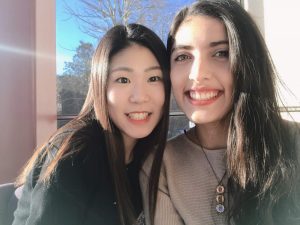
Chisato Hashimoto (Left) I’m a sophomore and Global studies major. I came to Castleton last year in late August. This is my last semeste here.
Shirley Benítez (Right) I’m a junior student in the career of Medicine in my country. I came to Castleton University this year for the Spring semester by being a part of the UGRAD program.
ABOUT THE BLOG
As international students, we talked about the life of studying abroad in the U.S. we usually compare it with our home country. Surprisingly, we can really empathize with each other, especially about the local students actions that are unbelievable in our country, differences in student life, professors, etc. We want to share with you about our experiences at Castleton and some pictures that will illustrate what we are talking about.
SURPRISING EXPERIENCES IN USA

Shirley Benítez
When I arrived Castleton I had a very warm welcoming from two students that were waiting for me, I was surprised because I didn’t expect that. That week we met people that work in different departments on Campus and everybody was very kind, I was impressed.
Honduran people are also very warm and welcoming, when we greet somebody, for saying “hello” or “goodbye” women greet men and other women with a kiss on the cheek, but men do not usually greet other men with a kiss on a cheek, they do hand shakes.
I am so glad for my experience at Castleton, especially because of the professors and all the resources they have for the students. It surprised me that every student has an advisor specific to their major, and how helpful they have been with their guidance. I also find the Academic Support Center resources helpful, as I take advantage of it. That is a resource we do not have at my university, probably because we have many students, about 90,000 compared to Castleton’s 2,000. So far, Castleton has felt more like a close community than my university back home.
It was interesting to see that people take off their shoes when entering a home, because back at home we do not do that. I thought it was typically a tradition in China and nowhere else.
~~~~~~~~~~~~~~~~~~~~~~~~~~~~~~~~~~
 Chisato Hashimoto
Chisato Hashimoto
- Warm welcome
I won’t never forget the day in August 19th. That was a long journey to get here. On my trip to Castleton from Osaka, I transited 3 times and it took more 24 hours to arrive at Albany airport. Usually, it doesn’t take so long to get here but I had a trouble and had to wait 5 hours in Dallas airport for the next flight. So I arrived at Albany around 1:00 AM. However, even though it was late at night, the Castleton staff came to pick me up by car. I was really really happy because they greeted me with a big smile. At that moment, I forgot that I was exhausted from my trip to Castleton and at the same time I’m glad chose Castleton University!
- U.S. Restroom
I still don’t feel at ease when I use the bathroom in the U.S because there is a wide gap at the bottom of the door and my legs can seen from outside also the door is small so whenever I enter the bathroom with carrying my backpack, I hit my arm on the door.
- Burp
Basically, a burp is a sound you make after eating and it goes against eating manners in Japan and seen as disrespectful. When I came to Vermont I saw many people burping after eating a meal and sometimes not during meal at all. I feel so strange when I hear someone’s burp. However, it was interesting for me to know that in China, Burping is a polite action with the meaning of gratitude that it was very delicious.
THESE ARE OUR UNIVERSITIES
HONDURAS
National Autonomous University of Honduras
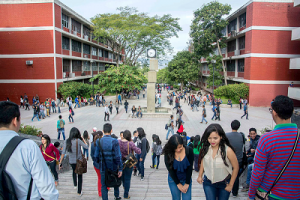
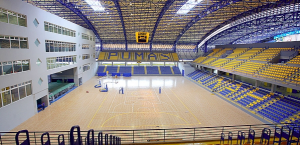
JAPAN
Doshisha Women’s College of Liberal Arts



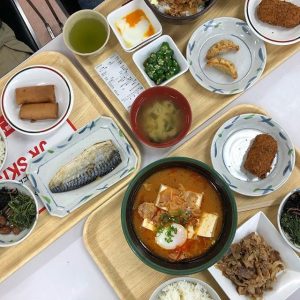
DEAR READER
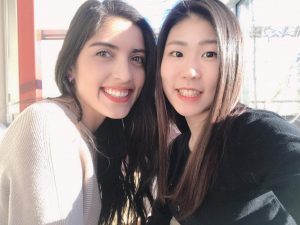
Thank you for taking the time to read our blog! We hope you enjoyed reading it! We have really enjoyed our wonderful experiences here at Castleton.
WE LOVE CASTLETON !!!!!!!!!!!!!!!!!!
By SHIRLEY & CHISATO




China Image
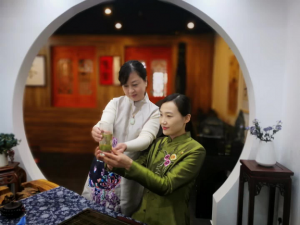

What is your first impression, when speaking of China? What image or word would you immediately have in your mind? The Great wall, the ancient palace, the historical cities, the aesthetic calligraphy, the delicate porcelain, the vibrantly colored silk scarf, the faint scent given by a cup of green tea, the simple-looking dumplings? Some interesting things about China are the followings below.
Southerners and Northerners:
There are two largest rivers in China, Yangtze River and Yellow River , which are cradle of the Chinese civilization, also form the boundary line between the southerners and northerners in China. There are some key differences in the flavor of cuisines and oral languages. One striking feature is that the food in the south tends to be sweet, and the southerners speak the soft tone language of Wu nong, which is also reflected on the different singing styles among various Chinese operas. Since there’s standard Chinese required to learn in school, there’s no barriers in communication among people from different places.



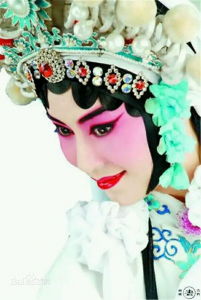
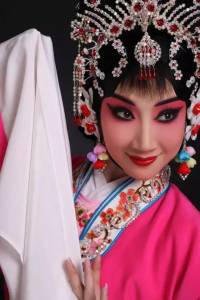
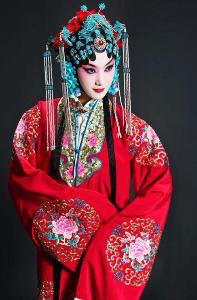
Sparsely populated areas and densely populated areas:
China is a multi-ethnic country, 56 nationalities in total now, the history of which can date back to Qing dynasty (the first united empire in China ( 221B.C.). The Han nationality is the largest one in China. Ethnic groups live together and gradually integrate. However, the population is unbalanced distributed between the east and the west because many people live in the flat and open plains and hilly areas in the east, where are also the first areas to be influenced by the economy reform policy.

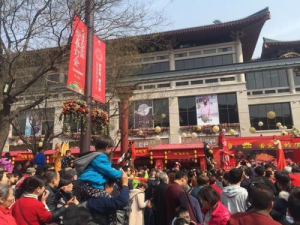
Religious and Non-religious:
The majority of the population is non-religious, but Confucianism forms the basis of the traditional culture of China, which emphasizes human morality and correct personal behavior. The founder, Confucius (551-479B.C.), gives high value to learning, peace, justice,etc. which are handed down from generation to generation, and fill the descendants with priceless treasure of wisdom. Diligence and courage, hard work and plain living, respecting the old and cherishing the young, striving for self-improvement are all our fine traditions.
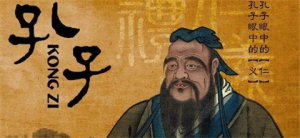
Agricultural and non-agricultural Economy:
China has a long history as an agricultural foundation economy. Nowadays the economical growth relies more increasingly on the development of science and technology. Ma Yun opened the first unattended hotel in Hang zhou one or two month ago. All the attendants there are computerized robots. Hong Kong-Zhuhai-Macao bridge, a huge cross-harbor bridge and tunnel project, was put to use at the end of 2018. To say that it is closely related to people’s daily, we have to mention the internet. Mobile phones are often used to pay for everything in China as long as you’re connected to the internet. We usually use Alipay and Wechat payment systems to complete the payment instead of cash, which brings people much convenience since there’s no need to take cash, especially change with you.

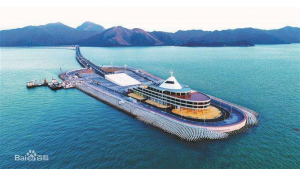
Kong-Zhuhai-Macao bridge:
The total length is 35 kilometers, with 6.7 kilometers of tunnels underseas, 22.9 kilometers of bridge, beginning in 2009, finished in 2018, worth of 126.9 billion yuan of the total investment, equal to 18.4 billion dollars.

Exam-oriented or Quality Education:
Imperial examination system has existed in China for 1300 years, beginning in Sui Dynasty(605 A.D.), ending in Qing Dynasty (1905A.D.). It emphasizes on the grasp of textbook knowledge about classic Chinese, law, math, etc. In the past, people believe that an intellect must be proficient in all kinds of music, chess, calligraphy and painting. Modern education emphasizes individual ideological and moral quality, ability cultivation, personality development, physical and mental health education.

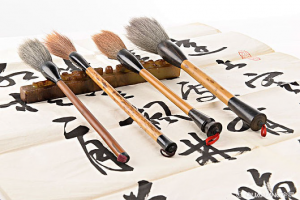
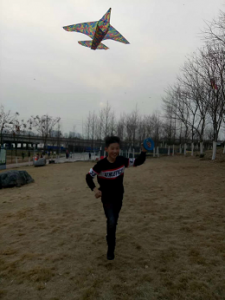
Taiji quan and Kong fu:
You must have seen a lot of Chinese martial arts films and think the Chinese Kong fu in them is wonderful. But do you know a slow moving Kong fu called Taiji quan? Taiji quan has developed based on the traditional Chinese philosophy of Confucianism and Taoism. It is said that it was created by Zhang Sanfeng in end of Yuan Dynasty(1271- 1368A.D.)and the beginning of Ming Dynasty(1368-1644A.D.). It stresses introspection and implicitness, combines rigidness and softness, overcomes rigidness with softness, reconcile Yin and Yang. It is popular among people because of its functions of cultivating temperament, building up physical fitness and practicing fighting skills. It is the most characteristic representative of Chinese Kong fu.
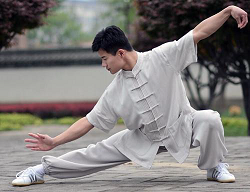
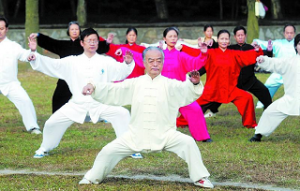
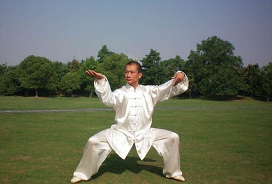
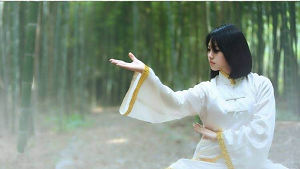
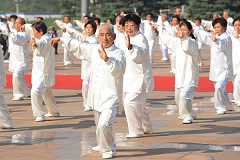
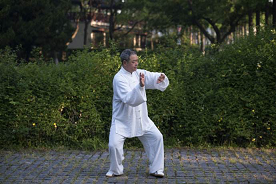
We are studying abroad here for a year as exchange students from Doshisha Women’s College of Liberal Arts in Japan. This is the last semester for us, so we would like to spread Japanese culture as much as possible and we are glad that many people here know about Japan. Today, we would like to introduce about some Japanese traditional events.
In this part, Shione Nishimura will talk about Japanese milestones in life. In Japan, there are some specific events through life. One of the examples is Shichi-Go-San. This is one of Japanese traditional ceremonies to celebrate children’s growth and pray for their future health. Shichi-Go-San literally means 7,5,3 in Japanese. This is a festival for three- and five-year-old boys, and three- and seven-year-old girls. Usually, children dress up in a kimono which is very traditional clothing in Japan. They take pictures in commemoration and go to a shrine with their parents for a ritual. They are given Chitose candy during the festival. Chitose means a long life, so they eat it to pray for live longer.
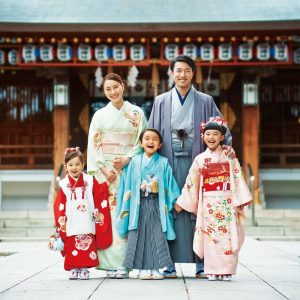
A 3-year-old girl, a 5-year-old boy, and a 7-year-old girl in the shrine
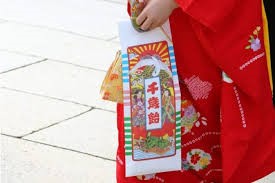
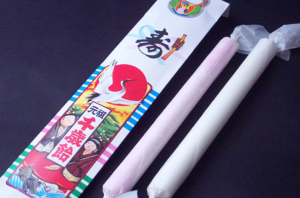
Chitose candy
When Japanese children become 20 years old, there is Coming of Age Day in January. In Japan, the age of becoming an adult is 20. Once you become 20 years old, you can drink alcohol and smoke cigarettes. The second Monday in January is a national holiday known as Coming of Age Day, and people who are 20 years old attend the ceremony as a ritual. Girls wear a kind of kimono which is traditional clothing called Furisode. The difference from other kimonos are the long sleeves, and it gives the most spectacular impression out of all kimono types. On the day of the ceremony, girls go to a beauty salon to help them put on their kimono because the way of wearing kimono is very difficult. They also do their hair up gorgeously in the beauty salon. Most boys wear suits, but some boys also were men’s kimono. Normally, they attend the ceremony at a public hall in their home town. At the ceremony, one of the 20-year-olds in the ceremony presents his/her goals as a representative of the new adults, and mayor of the city gives a speech to them. Sort of like an alumni gathering, they have the chance to meet some friends they haven’t seen for a long time. After the ceremony, it is common for them to go drinking alcohol with their friends like party. Then, they change their clothing from kimono to western dress. Actually, it was time for us to attend the ceremony this winter because we all are 20 years old. However, we couldn’t attend it because of studying abroad here now. I felt a trifle sad, but I was glad to see pictures of my friends looking grown up and beautiful.
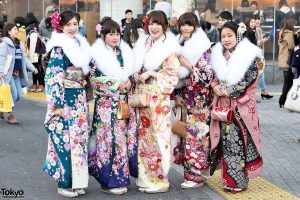
Furisode (kind of Japanese kimono)
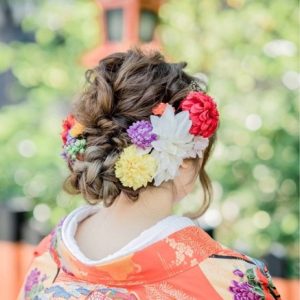
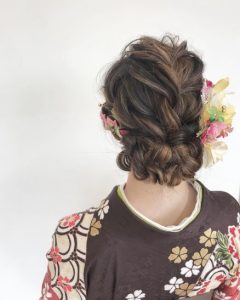
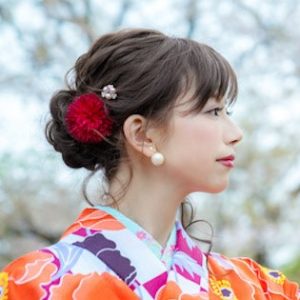
Hair styles
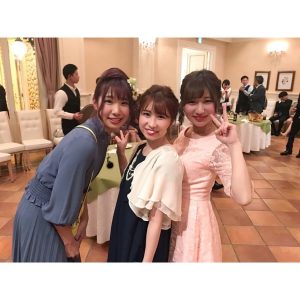
After the ceremony
Next, Rurika Fujita will introduce some traditional annual events in Japan. We have some events depending on the month. For example, in February, we have an event which is called ‘Setubun’ and this event is held on February 3rd every year. On this day, we buy a lot of soybeans, because we throw these soybeans to ‘oni’. ‘Oni’ is like a monster human body, which has a red or blue face. The reason why we throw soybeans is that there is a theory that on February 3 ‘Oni’ come to us and they bring evil spirits. That’s why people buy many soybeans and they throw to ‘Oni’. Generally, someone in the family puts on the mask of ‘Oni’ and they pretend to be an ‘Oni’. After we throw soybeans, we eat soybeans of a number of our ages. It is said that if you eat soybeans of a number of your age, you can be healthy without getting sick. In addition to this February event, we have Valentine’s day on February 14. Certainly, this event is famous in the United State, but in Japan, it is a little different compared to in the United States, because generally, a girl gives chocolate to a boy. It is the opposite of America.
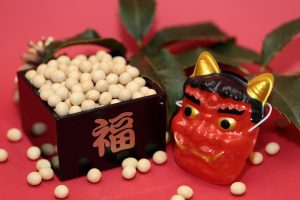

Setubun February 3, Soybeans and Oni
Secondly, I will introduce the event of July. On July 7, we have an event which is called ‘Tanabata’. On this day we write our wish on paper and we put the paper on bamboo grass. Besides the paper which we write wish, we decorate bamboo grass with colorful origami.
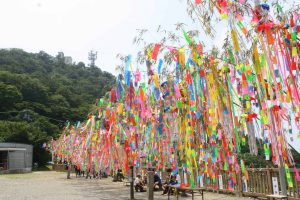
Tanabata July 7
Finally, I will introduce the New Year’s Eve and new year events. On December 31, most people spend time with family and they celebrate the new year together. Before the new year comes, we eat Toshi-Koshi soba. There are three reasons why we eat soba. The first reason is that if you eat soba, you can live longer because soba is thin and long. The second reason is we can cut the bad fate of last year because soba is easier to cut than other noodles. The final reason is that it is said that if you eat soba, you can collect money because a craftsman who handles gold and silver collects powder of gold and silver by using soba flour. From these three reasons, Japanese people eat soba before New Year’s Day arrives. After the New Year arrives, on January 1st, we go to a shrine to wish for our wish. Moreover, on the same day, we eat ‘Oseti’. It is a very traditional food and its appearance is really cool.
Besides these traditional events, we have a lot of other special events! So, visit Japan and please experience these Japanese events!
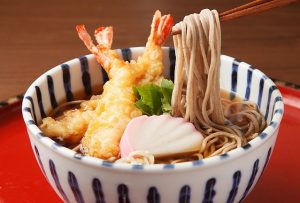
Toshi-Koshi soba December 31
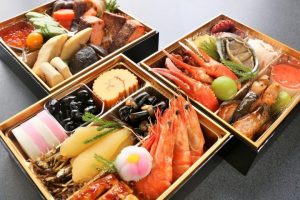
Oseti January 1
I came to Castleton from Doshisha Women’s College in Japan as an exchange student. When you hear about Japan, what do you associate it with? There are some unique culture elements in Japan, but today I want to introduce Japanese Ofuro culture. Ofuro means bath in English. I remember the moment when I arrived at Castleton University, I was surprised there was no bathtub in my dorm.
First of all, Ofuro has been part of Japanese daily habit since 350 years ago. According to Naito who is a writer of the Japan Times, “Japanese take a bath five times a week in summer and six times a week in winter” (Japan Times, 2001). This aspect of culture is brought by Japanese characteristic weather and natural features. Japan is rich in water. Also, Japanese summers are hot and humid compared with Europe. So we can pool water and we take a bath to clean our sweaty body. In addition, modern technology can make hot water easily.
Almost all Japanese houses have their own bathtub. The size of the bathtub depends on the building. In general, bathtubs have enough room that person who is 5.2ft can relax.
Some people who aren’t Japanese think it is enough to take a shower only. However, I really want you to know that there are a lot of benefits to soaking in a bath. For example, it provides us relaxation effect. Also, it can get rid of fatigue and stress. Hot water keeps our body warm in winter. If you have children, bath time is a good place to communicate with your children. These examples are just a small part of the advantages.
These day there are many kinds of items in Japan for enjoying bath time. Some people put a TV on the bath wall and enjoy watching it. Others turn off the lights and light an aromatic candle.
I really miss Ofuro because more than half a year has passed since I started only taking showers. I’m planning to soak in the bath for at least an hour when I go back to Japan. It used be to difficult for people who have a tattoo to go to Japanese hot springs because tattoos represented villains such as yakuza or gangsters in Japan. However, thanks to increasing foreign tourists, there are some hot springs recently welcoming those who have tattoos. So I recommend visiting the famous hot springs when you come to Japan. You will definitely love it!
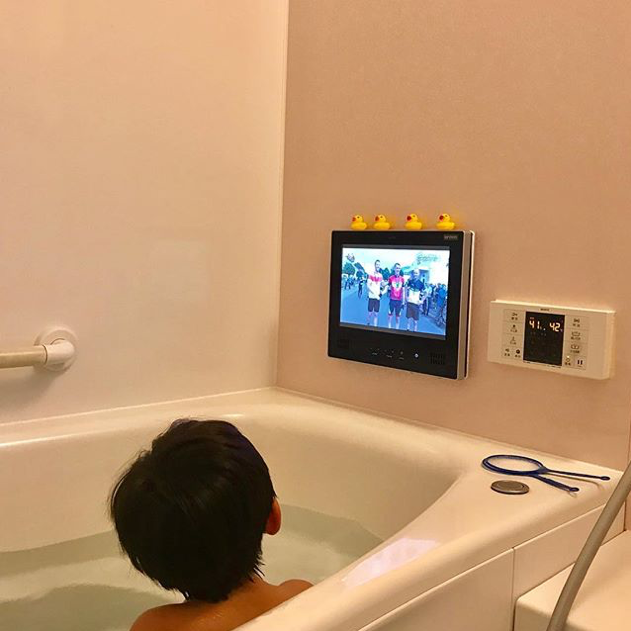
A child enjoying watching TV while soaking in the bath
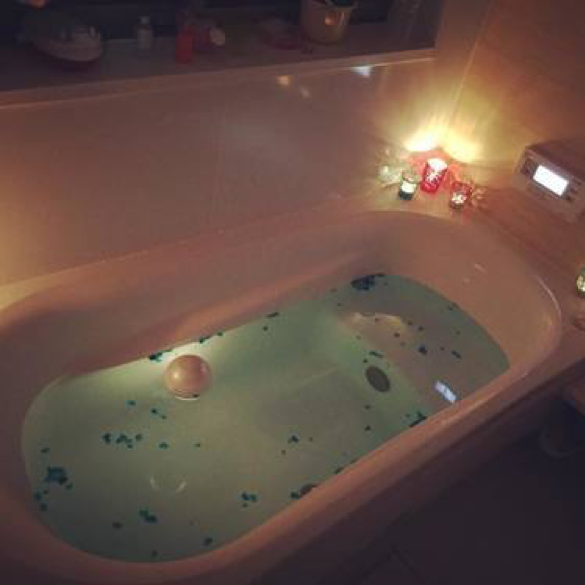
A bathtub with aromatic candles

Japanese common type of bath room

Just press correct button, we can supply hot water into a bathtub automatically and also can change the hot water’s temperature.
We usually set the temperature from 104 degrees F to 109 degrees F.
I am here in Castleton, along with three others, for the Global Undergraduate Exchange Program of the US Department of State. The program has two components: (1) academic, and (2) cultural. While I am here to immerse myself in American culture, I find it also fitting to share bits and pieces of the Philippines, an archipelagic country in the Pacific that has a close, but also controversial, relationship with the United States since the Spanish-American War.
As of the latest count, the Philippines is composed of 7, 641 islands and has a population of 104.9 million, composing 175 ethnic groups. It is also a reservoir of languages with 134 Philippine languages and hundreds more local dialects, according to the Komisyon sa Wikang Filipino (Commission on the Filipino Language). These numbers speak of, and all contribute to, the cultural diversity of Filipinos—furthered by various influences such as our Arab and Chinese trading relations which could be traced as far back as the pre-colonial period, and colonial experience from 3 different groups (Spain, US, Japan) spanning almost 4 centuries.
I could share a lot about the Philippines given the immense cultural diversity present in my home country, but I choose to focus on one figure in the streets of different cities in the archipelago: an ever-present but often unrecognized figure in the Philippine urban jungle.
===
Worldwide, dogs bark. In the Philippines, people do too.
Down the chaotic streets of cities in the Philippines, alongside large buses, private cars, and taxi cabs, a conspicuous and anachronistic mode of public transport makes its way through—the Philippine jeepney. Usually painted with bright colors and adorned with glaring accessories, the jeepney is a post-WW2 innovation which has become a cultural symbol as it earned its spot as the “King of the Road” in the Philippines.

(KING OF THE ROAD. A jeepney is a post-WW2 mode of public transport endemic to the Philippines. If NYC is known for its yellow taxi cabs, jeepneys just might be that for the Philippines. Image from: https://media.npr.org/assets/img/2018/03/06/gettyimages-689876692_custom-54d75b9db7ea9eae2c26488c21d64c4512795846-s800-c85.jpg)
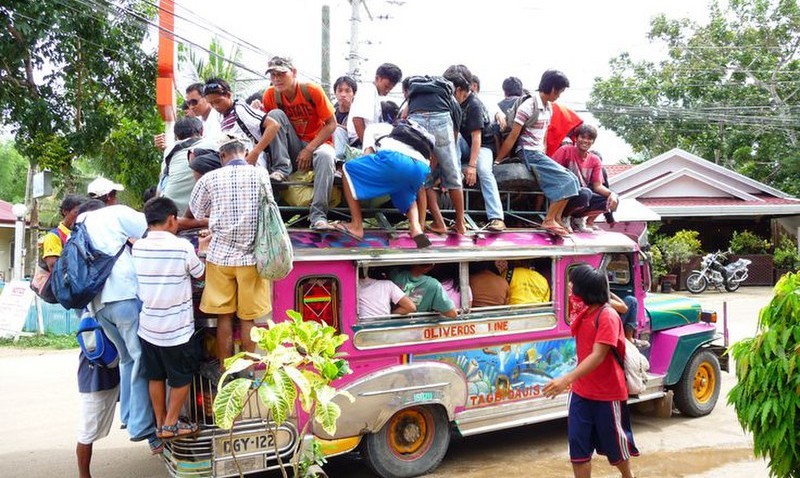
(SABIT. In certain places, even the top of jeepneys are occupied by passengers just so they would reach their destinations. Some even cling on to the outside railings, notwithstanding the scorching heat and polluted air. Image from: http://ibon.org/file/2017/12/Jeepneys_travelblogorg-800×478.jpg)
Beside these jeepneys waiting for passengers are the jeepney barkers, people who earn a living using their loud and booming voices. In the hustle and bustle of streets and roads in the Philippines, the jeepney barkers’ voices standout. Ironically, these same people are those who are not heard that much in terms of occupational identity. Worse, barkers generally have a negative image, an image which hides what might be one of the last altruistic roles in the Philippine urban jungle.

(Photo from: https://media.philstar.com/images/the-philippine-star/nation/20160122/Minimum-Fare-Jeepney-PUJ.jpg)
So what does a jeepney barker really do?
They are the people who would convince you to ride a jeepney going North when you’re really headed South. They are the people who will convince you to ride the jeep even if only half of your butt can sit because in their minds, “onsehan yang jeep oh, sampu pa lang kayo diyan sa kanan at kaliwa, o usog usog nalang po tayo diyan sa kanan sa kaliwa” (“The jeepney can accommodate 11 even people per side, you’re just 10, please move your butts, move, left, right!). They probably have not taken into consideration that people’s sizes differ.
Generally, jeepney barkers earn a living just by yelling and yelling and yelling to attract passengers. Occasionally, they would wave their hands to attract more passengers. Others would have other unconventional tactics (or even antics) to attract people. Seems simple right? Interestingly, there seems to be an unwritten code of ethics among jeepney barkers.
Since the barkers technically work for the jeepney drivers, they need to accept whatever amount the jeepney drivers gives them—or in some cases, throws at them. It’s basically a voluntary contribution—a donation at that. There’s no written contract that stipulates how much the driver should pay the barker. May that be a mere one peso coin (0.019 USD) or twenty peso bill (0.38 USD), the barker has no choice but to be thankful for the small amount given. And who knows, when a relationship with the driver is built and maintained, the small amount given can gradually increase.
Also, it is interesting to note that jeepney barkers know the concept of personal space. While they are attracting passengers to ride the jeepney, they make sure that they don’t touch the passenger—even the slightest tap on the shoulder could have repercussions. My friend got the chance to interview a jeepney barker based in Manila (the capital of the Philippines) for a documentary. The jeepney driver shared that he was once accused of “chansing” (inappropriate touching) when his hand accidentally touched a woman’s arm. While this may be a gray area, the jeepney barker stressed that since then, he made sure that his hands wouldn’t touch a passenger.
It is also interesting that jeepney barkers go out of their way to help passengers carrying heavy baggage who want to take the jeepney. While their jobs are mainly focused in attracting passengers to ride the jeepney, barkers actually go out of their way to assist the passengers—especially the elderly. They do this without asking for anything in return—and rarely do we see passengers giving them incentive for their good deed.

(Photo from: https://assets.rappler.com/9FC038C1255841BD8E609039F533BD81/img/04F7C7D3EB304CD292CAA3213B4CD4F1/jeepney-fare-provisional-hike-july-5-2018-001.jpg)
On the other hand, it is also important to note that there are people who view jeepney barkers in a negative light.
People may consider being a jeepney barker as a destiny for the lazy people—those that would prefer shouting all-day in the polluted streets under the scorching sun. There is a certain perception that jeepney barkers are those who do not have anything better to do, or worse, those who not interested in doing anything else. Barkers are perceived as the people whose skills are enclosed to merely the memorization of jeepney routes and jeepney capacity.
However, is this really the case? While jeepney barking is perceived as the occupation of the hopeless and the desperate, there are some jeepney barkers who prove otherwise.
In a pre-production research for a documentary being produced by a friend, I got to talk to a barker stationed in a mall’s transport terminal. He shared that he is an electrician and that he resorts to jeepney barking when he has no customers. He also shared that more often than not, his takehome pay from jeepney barking is even higher than what he earns as a freelance electrician.
This story shows that jeepney barkers are not those lazy people the society portrays them to be. Instead, the story of the barker I got to talk to and several other stories gathered by my friends show that it is precisely because of their industry and diligence that jeepney barkers chose this occupation—regardless of the societal prejudice that comes with their job, they continue to do so just so they could provide for themselves and their families.
For jeepney barkers, their lives depend on their voices. But it also important that they are given their own voices—a voice that everyone would listen to not just because they are shouting endlessly in the polluted streets of the metro. There is a pressing need for them to have their own voice in the society.
The streets of the urban jungle scream of excess labor. The presence of jeepney barkers, alongside other occupations in the streets, show that there are many unemployed and underemployed Filipinos who continue to dream for a better life. While there is no better employment opportunity, they resort to working as barkers or something similar so as not to waste time.
In a larger picture, the presence of jeepney barker—something “only in the Philippines”—mirror the apparent lack of opportunities especially for those who do not hold a degree. The presence of jeepney barkers and other street-based occupations mirror the plight of the ordinary Filipino—the simple goal of eating three times a day, with something to pair with rice, the Filipino staple.
But more than anything, the presence of jeepney barkers in the Philippine urban jungle also mirrors the “diskarte” (closest English counterpart I could think of is strategy) and the diligence of Filipinos just so they could have food in the table. The presence of jeepney barkers remind us that even the seemingly most menial jobs are meaningful jobs. While they may not have offices nor promotional opportunities, jeepney barkers exemplify the willingness of Filipinos to do anything and everything just to ensure that their families are given their basic needs.
As long as there are mouths that need to be fed, and as long as no better opportunities come their way, jeepney barkers’ calls and voices will continue to be heard in the hustle and bustle of the streets of the metro. As long as there are Filipinos would be willing to shout all-day for food and other needs, then jeepney barkers will continue to exist.
Worldwide, dogs bark. In the Philippines, people bark, too—and their presence shows two sides of a coin. It shows the lack of employment opportunities, and the increasing wealth divide in the country. It shows the plight of the ordinary Filipino caged by dysfunctional labor systems. But it also shows the persistence and diligence of the ordinary Filipino. It shows the Filipino resilience amidst societal inequalities. Barking in the Philippines provides sustenance for many families. While this may not be glamorous, this is what they need. At least for now.
We love seeing our international students in the news. Madelaine Kopischke, a junior film studies major from Germany, attended the 2018 Popular Culture Association and American Culture Association National Conference in Indianapolis, Indiana this spring to present her video essay to a panel of scholars from around the country. Way to go Madelaine!
For more information about Madelaine and her work at this national conference, read the article in The Castleton Spartan .


Ben (Australia), Frank (China), Mitchell (USA)
Did you know that at the end of your first year at Castleton you can apply to be a Community Advisor, or CA? A CA at Castleton is similar to what other universities call a Resident Assistant or Advisor (RA). As an on-campus job, it meets the F-1 visa employment regulations. CAs are assigned to a residence hall floor of 30-50 students. Their main job is to keep the residencies safe, but also to organize fun and interesting programs for the residents. The job is demanding, but it pays a stipend and your board (room fee) is waived. The job is also very rewarding. Just listen to what a couple of international CAs have to say.
Ben Mrowka, CU ’19 (Australia)
I enjoy being a CA because I am able to connect to a huge amount of students and I am able to contribute to the CU community. I am learning a great deal from the job, and I will be able to use this knowledge about leadership, making tough decisions and being a role model for any job that I find myself in. Dealing with people will always bring its challenges but through this position, I have found myself improving and learning every day.
Zijie (Frank) Wan, CU ’20 (China)
What I like about this job are the social aspects, friendships, and responsibilities. It has been almost a year since I became a CA, and I have already learned a lot from this experience. Becoming more outgoing and social might be the most obvious change I have undergone. I really enjoy the feeling of hanging out with CAs and residents, because it makes me feel bonded to them. It is like having a family in the United States!
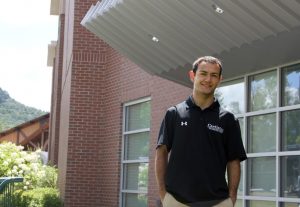
Paolo Loli, CU ’17, Community Advisor

Paul Rechberger, National Slalom Champion
Earlier this month, the Castleton’s men’s and women’s alpine ski teams competed in the USCSA National Championships at Whiteface Mountain in Lake Placid, New York . The women’s team finished third place overall, after finishing second in the slalom and third in the giant slalom. The men achieved a four-way tie for first place overall, and were just .04 seconds away from a first place finish in the slalom. Congratulations to Li Aunes (Sweden), Linn Ljungemo (Sweden), Oskar Eriksson (Sweden), Jan Klindic (Croatia), Paul Rechberger (Austria), and Anton Smith (Sweden)!

Castleton’s Women’s Alpine Team

Castleton’s Men’s Alpine Team (left side)

Emily and Monica
By Qin (Emily) Wang, Castleton student from China
I want to share with you some of my recent events. Last weekend I with Monica and a friend went skiing in Pico. This was my first time skiing. I took an introductory course, but I still don’t quite know how to slow down and stop. I couldn’t control the acceleration and it was really terrible! Then the coach kept saying “make your pie” but I couldn’t think and only shouted “I have no pie!!!” And I have to say that the fall is really very painful?
(Editor’s note: Ski instructors will often use the term, “pie”, to describe a snowplow, which helps to control a skier’s speed. The stance looks similar to a piece of pie, with tips together and tails apart. This term was unfortunately lost in translation for Emily!)
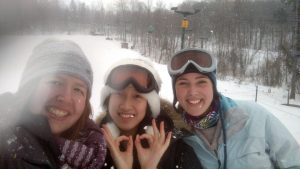
Learning to Ski at Pico Mountain